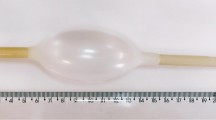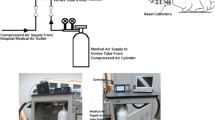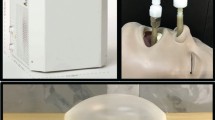Abstract
Background
Mild hypothermia is an effective neuroprotective strategy for a variety of acute brain injuries. Cooling the nasopharynx may offer the capability to cool the brain selectively due to anatomic proximity of the internal carotid artery to the cavernous sinus. This study investigated the feasibility and efficiency of nasopharyngeal brain cooling by continuously blowing room temperature or cold air at different flow rates into the nostrils of normal newborn piglets.
Methods
Experiments were conducted on thirty piglets (n = 30, weight = 2.7 ± 1.5 kg). Piglets were anesthetized with 1–2 % isoflurane and were randomized to receive one of four different nasopharyngeal cooling treatments: I. Room temperature at a flow rate of 3–4 L min−1 (n = 6); II. −1 ± 2 °C at a flow rate of 3–4 L min−1 (n = 6); III. Room temperature at a flow rate of 14–15 L min−1 (n = 6); IV. −8 ± 2 °C at a flow rate of 14–15 L min−1 (n = 6). To control for the normal thermal regulatory response of piglets without nasopharyngeal cooling, a control group of piglets (n = 6) had their brain temperature monitored without nasopharyngeal cooling. The duration of treatment was 60 min, with additional 30 min of observation.
Results
In group I, median cooling rate was 1.7 ± 0.9 °C/h by setting the flow rate of room temperature air to 3–4 L min−1. Results of comparing different temperatures and flow rates in the nasopharyngeal cooling approach reveal that the brain temperature could be reduced rapidly at a rate of 5.5 ± 1.1 °C/h by blowing −8 ± 2 °C air at a flow rate of 14–15 L min−1.
Conclusions
Nasopharyngeal cooling via cooled insufflated air can lower the brain temperature, with higher flows and lower temperatures of insufflated air being more effective.





Similar content being viewed by others
References
Sadaka F, Veremakis C. Therapeutic hypothermia for the management of intracranial hypertension in severe traumatic brain injury: a systematic review. Brain Inj. 2012;26:899–908.
Quinn MW, Munyard PF. Treatment of asphyxiated newborns with moderate hypothermia in routine clinical practice: how cooling is managed in the UK outside a clinical trial. Arch Dis Child Fetal Neonatal Ed. 2010;95:F152.
Uray T, Haugk M, Sterz F, Arrich J, Richling N, Janata A, Holzer M, Behringer W. Surface cooling for rapid induction of mild hypothermia after cardiac arrest: design determines efficacy. Acad Emerg Med. 2010;17:360–7.
Moore EM, Nichol AD, Bernard SA, Bellomo R. Therapeutic hypothermia: benefits, mechanisms and potential clinical applications in neurological, cardiac and kidney injury. Injury. 2011;42:843–54.
Povlishock JT, Wei EP. Posthypothermic rewarming considerations following traumatic brain injury. J Neurotrauma. 2009;26:333–40.
Bullock MR, Povlishock JT. Guidelines for the management of severe traumatic brain injury. J Neurotrauma. 2007;24(Suppl 1):S1–106.
Mathur NB, Krishnamurthy S, Mishra TK. Evaluation of who classification of hypothermia in sick extramural neonates as predictor of fatality. J Trop Pediatr. 2005;51:341–5.
Sterz F, Safar P, Tisherman S, Radovsky A, Kuboyama K, Oku K. Mild hypothermic cardiopulmonary resuscitation improves outcome after prolonged cardiac arrest in dogs. Crit Care Med. 1991;19:379–89.
Jia X, Koenig MA, Shin HC, Zhen G, Pardo CA, Hanley DF, Thakor NV, Geocadin RG. Improving neurological outcomes post-cardiac arrest in a rat model: immediate hypothermia and quantitative eeg monitoring. Resuscitation. 2008;76:431–42.
Zhao D, Abella BS, Beiser DG, Alvarado JP, Wang H, Hamann KJ, Hoek TL, Becker LB. Intra-arrest cooling with delayed reperfusion yields higher survival than earlier normothermic resuscitation in a mouse model of cardiac arrest. Resuscitation. 2008;77:242–9.
Eun D, Bhandari A, Boris R, Lyall K, Bhandari M, Menon M, Rogers CG. A novel technique for creating solid renal pseudotumors and renal vein-inferior vena caval pseudothrombus in a porcine and cadaveric model. J Urol. 2008;180:1510–4.
Culic S. Cold injury syndrome and neurodevelopmental changes in survivors. Arch Med Res. 2005;36:532–8.
Dudgeon DL, Randall PA, Hill RB, McAfee JG. Mild hypothermia: its effect on cardiac output and regional perfusion in the neonatal piglet. J Pediatr Surg. 1980;15:805–10.
Sanae T, Kazama S, Nie M, Miyoshi Y, Machii M, Ohara K, Yoshimura H. Free-floating left atrial ball thrombus early after mitral valve replacement. Ann Thorac Cardiovasc Surg. 2000;6:408–10.
Gillan LA. Blood supply to brains of ungulates with and without a rete mirabile caroticum. J Comp Neurol. 1974;153:275–90.
Covaciu L, Allers M, Enblad P, Lunderquist A, Wieloch T, Rubertsson S. Intranasal selective brain cooling in pigs. Resuscitation. 2008;76:83–8.
Wolfson MR, Malone DJ, Wu J, Hoffman J, Rozenberg A, Shaffer TH, Barbut D. Intranasal perfluorochemical spray for preferential brain cooling in sheep. Neurocrit Care. 2008;8:437–47.
Boller M, Lampe JW, Katz JM, Barbut D, Becker LB. Feasibility of intra-arrest hypothermia induction: a novel nasopharyngeal approach achieves preferential brain cooling. Resuscitation. 2010;81:1025–30.
Tsai MS, Barbut D, Wang H, Guan J, Sun S, Inderbitzen B, Weil MH, Tang W. Intra-arrest rapid head cooling improves postresuscitation myocardial function in comparison with delayed postresuscitation surface cooling. Crit Care Med. 2008;36:S434–9.
Wang H, Barbut D, Tsai MS, Sun S, Weil MH, Tang W. Intra-arrest selective brain cooling improves success of resuscitation in a porcine model of prolonged cardiac arrest. Resuscitation. 2010;81:617–21.
Thoresen M, Hobbs CE, Wood T, Chakkarapani E, Dingley J. Cooling combined with immediate or delayed xenon inhalation provides equivalent long-term neuroprotection after neonatal hypoxia-ischemia. J Cereb Blood Flow Metab. 2009;29:707–14.
Harris BA, Andrews PJ, Murray GD. Enhanced upper respiratory tract airflow and head fanning reduce brain temperature in brain-injured, mechanically ventilated patients: a randomized, crossover, factorial trial. Br J Anaesth. 2007;98:93–9.
Mariak Z, White MD, Lewko J, Lyson T, Piekarski P. Direct cooling of the human brain by heat loss from the upper respiratory tract. J Appl Physiol. 1985;1999(87):1609–13.
Dohi K, Jimbo H, Abe T, Aruga T. Positive selective brain cooling method: a novel, simple, and selective nasopharyngeal brain cooling method. Acta Neurochir Suppl. 2006;96:409–12.
Enviroment Canada (http://www.Ec.Gc.Ca/toxiques-toxics/default.Asp?Lang=en&n=98e80cc6-1&xml=aa329670-c3c7-4ad5-a7ab-5fd8a05439f1) [accessed 29 August, 2012].
Azzopardi D, Strohm B, Edwards AD, Halliday H, Juszczak E, Levene M, Thoresen M, Whitelaw A, Brocklehurst P, Steering G, Participants TCR. Treatment of asphyxiated newborns with moderate hypothermia in routine clinical practice: How cooling is managed in the UK outside a clinical trial. Arch Dis Child Fetal Neonatal Ed. 2009;94:F260–4.
Roohey T, Raju TN, Moustogiannis AN. Animal models for the study of perinatal hypoxic-ischemic encephalopathy: a critical analysis. Early Hum Dev. 1997;47:115–46.
Herpin P. Development of thermoregulation and neonatal survival in pigs. Livest Prod Sci. 2002;78:25–45.
Bakhsheshi MF, Stewart EE, Morrison L, Lee TY. Comparison of selective brain cooling in juvenile and newborn piglets using a nasopharyngeal method. The 8th International Conference on Brain Monitoring and Neuroprotection in the newborn. 2014.
Bratton SL, Chestnut RM, Ghajar J, McConnell Hammond FF, Harris OA, Hartl R, Manley GT, Nemecek A, Newell DW, Rosenthal G, Schouten J, Shutter L, Timmons SD, Ullman JS, Videtta W, Wilberger JE, Wright DW. Guidelines for the management of severe traumatic brain injury. X. Brain oxygen monitoring and thresholds. J Neurotrauma. 2007;24(Suppl 1):S65–70.
Bratton SL, Chestnut RM, Ghajar J, McConnell Hammond FF, Harris OA, Hartl R, Manley GT, Nemecek A, Newell DW, Rosenthal G, Schouten J, Shutter L, Timmons SD, Ullman JS, Videtta W, Wilberger JE, Wright DW. Guidelines for the management of severe traumatic brain injury. Ix. Cerebral perfusion thresholds. J Neurotrauma. 2007;24(Suppl 1):S59–64.
Chen RY, Chien S. Hemodynamic functions and blood viscosity in surface hypothermia. Am J Physiol. 1978;235:H136–43.
Polderman KH, Peerdeman SM, Girbes AR. Hypophosphatemia and hypomagnesemia induced by cooling in patients with severe head injury. J Neurosurg. 2001;94:697–705.
Koht A, Cane R, Cerullo LJ. Serum potassium levels during prolonged hypothermia. Intensive Care Med. 1983;9:275–7.
Szczesny G, Veihelmann A, Massberg S, Nolte D, Messmer K. Long-term anaesthesia using inhalatory isoflurane in different strains of mice-the haemodynamic effects. Lab Anim. 2004;38:64–9.
Sessler DI. Mild perioperative hypothermia. N Engl J Med. 1997;336:1730–7.
Xiong J, Kurz A, Sessler DI, Plattner O, Christensen R, Dechert M, Ikeda T. Isoflurane produces marked and nonlinear decreases in the vasoconstriction and shivering thresholds. Anesthesiology. 1996;85:240–5.
Bhatti MT. Orbital syndromes. Semin Neurol. 2007;27:269–87.
Acknowledgments
The authors would also like to thank Laura Morrison and Jennifer Hadway for their help in conducting the animal experiments. All work was performed in Lawson Health Research Institute.
Author information
Authors and Affiliations
Corresponding author
Ethics declarations
Conflicts of Interest
None.
Funding
Lawson Health Research Institute.
Rights and permissions
About this article
Cite this article
Fazel Bakhsheshi, M., Stewart, E.E., Tai, J.H. et al. Efficacy of Selective Brain Cooling Using a Nasopharyngeal Method in Piglets. Neurocrit Care 24, 140–149 (2016). https://doi.org/10.1007/s12028-015-0195-9
Published:
Issue Date:
DOI: https://doi.org/10.1007/s12028-015-0195-9




